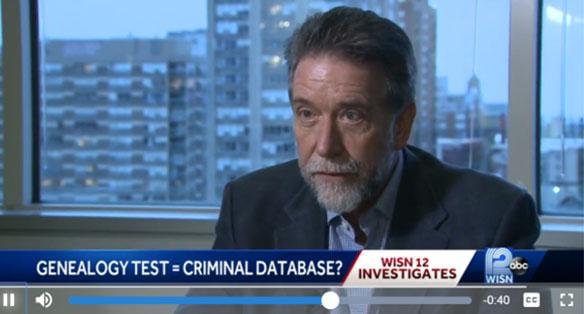DNA Genealogy Data Used to Solve Crimes – Promises and Perils


By Raymond Dall’Osto and Jason Luczak
Today in America, we are regularly presented with headlines, promotions, and offers on digital and other media that tell us that by submitting a DNA sample (spit into small bottle and mail it in), this will provide a great way to connect generations, build a family tree, and find out more than just the place you’re from through Ancestry DNA and Ancestry Health. A different well-known firm, 23andme, offers equivalent services through its DNA Ancestry + Traits and Health + Ancestry.
On television, the widely-popular Find Your Roots series on PBS with Henry Louis Gates shows how DNA tests, coupled with traditional genealogy, can find unexpected results, roots and similar connections. Crime shows on television and in movies abound with the regular and glorified use of DNA technology to catch criminals.
The types of DNA typing currently utilized by law enforcement and other forensic examiners include polymerase chain reaction (PCR), short tandem repeats (STR), Y-chromosome, and mitochondrial DNA.
PCR Analysis
The evolution of DNA testing advanced significantly when Dr. Kary Mullis discovered that DNA could be copied in the laboratory, much like it is in the natural world. This copying process, known as polymerase chain reaction (PCR), uses an enzyme (polymerase) to replicate DNA regions in a test tube. By repeating the copying process, a small number of DNA molecules can be reliably increased up to billions within several hours. Remember what the scientists did in Jurassic Park?
The DNA typing technique first used by law enforcement agencies, restricted fragment length polymorphism (RFLP) analysis, requires a biological sample about the size of a quarter, but PCR can be used to reproduce millions of copies of the DNA contained in just a few skin cells. Since PCR analysis requires only a minute quantity of DNA, it can enable the laboratory to analyze highly degraded evidence for DNA. On the other hand, because the sensitive PCR technique replicates any and all of the DNA contained in an evidence sample, greater attention to contamination issues is necessary.
STR Analysis
Short tandem repeat (STR) technology is a forensic analysis that evaluates specific regions (loci) that are found on nuclear DNA. The variable nature of the STR regions that are analyzed for forensic testing intensifies the discrimination between one DNA profile and another. For example, the likelihood that any two individuals (except identical twins) will have the same 13-loci DNA profile can be statistically estimated as being as high as 1 in 1 billion.
The Federal Bureau of Investigation (FBI) has chosen 13 specific STR loci to serve as the standard for its Combined DNA Index System (CODIS) and data base. Most states, including Wisconsin, also have DNA databases. The purpose of establishing a core set of STR loci is to ensure that all forensic laboratories establish uniform DNA databases and share valuable forensic information.
Y-Chromosome Analysis
Several genetic markers have been identified on the Y chromosome that can be used in forensic applications. Y-chromosome markers target only the male fraction of a biological sample. Therefore, this technique can be very valuable if the laboratory detects complex mixtures (multiple male contributors) within a biological evidence sample. Because the Y chromosome is transmitted directly from a father to all of his sons, it can also be used to trace family relationships among males.
Mitochondrial DNA Analysis
Mitochondrial DNA (mtDNA) analysis allows forensic laboratories to develop DNA profiles from evidence that may not be suitable for RFLP or STR analysis. While RFLP and PCR techniques analyze DNA extracted from the nucleus of a cell, mtDNA technology analyzes DNA found in a different part of the cell, the mitochondrion.
It is important to note that all maternal relatives, e.g., a person's mother or maternal grandmother, have identical mtDNA. This enables unidentified remains to be analyzed and compared to the mtDNA profile of any maternal relative for the purpose of assisting in cold case, missing persons, or unidentified remains investigations.
Old remains and evidence lacking nucleated cells—such as hair shafts, bones, and teeth—that are not amenable to STR and RFLP testing may yield results if mtDNA analysis is performed. For this reason, mtDNA testing can be very valuable to the investigation of an unsolved case, identification of long dead military personnel and pilots, etc.
DNA Genealogy Profiles Used to Identify Criminal Suspects
In addition to the above four types of conventional DNA typing and analysis, a new means of using genetic profiles has developed utilizing the popular and less known databases collected and available from commercial genealogy companies and sites. The solving in 2019 of cold cases involving the so-called Golden State killer, as well as a long-unsolved case in Wisconsin, have sparked considerable media and public interest and attention.
The upside for the public is that by using existing commercial databases, regardless of donors’ knowledge or consent, the criminal is identified, perhaps arrested, and the case solved. However, considerable valid concerns about how this happens; whose DNA profiles are being accessed, examined, and used; and what, if any, privacy rights or protections exist for users of genealogy databases are now being aired and discussed.
A recent journal article, “The Law of Genetic Privacy: applications, implications and limitations,” 6 Journal of Law and Biosciences (Oct. 2019), states that most people view healthcare and genetic information about themselves as private. Each person’s genome, or full complement of DNA, is unique, but the specific variants within an individual’s genome may be widely shared with biological relatives and even across the entire human population. This mixed character of the genome—as a uniquely individual assemblage of widely shared common elements—imbues it with a dual private and public significance that confounds any discussion of policy addressing genetic privacy. On one hand, DNA has been conceptualized as a unique identifier and a person’s “book of life,” which provides insights into many aspects of the person’s make-up and future. But who has access to this book, and how is the use of the resulting information regulated, if at all?
This concern leads many people to want to control who has access to their genetic information about them to support strong privacy protections or even personal genetic data ownership. Significant concepts within the realm of genetic privacy are informational privacy (who has access to personal information), confidentiality, security, and anonymity.
Deciding how much control people should have over the access to and use of their genetic data about is taking on increased urgency. Until recently, there simply was less genetic information to worry about, because a person’s genetic makeup could be inferred only by studying his or her phenotypic characteristics and family history, e.g., eye color. Dramatic advances in technology and methods, and the proliferation and widespread popularity of DNA-based genealogy, has now made it possible to examine DNA directly, over large (and often unsuspecting) populations, with increasing accuracy.
To what end, for what purposes, and by whom? Should insurance companies be allowed access to health-related DNA records without the knowledge and consent of the donor? Should there be protections providing for a search warrant, some kind of advance notice, consent, limited access, or should these databases be wide-open to whomever might want access to them, like criminal and court histories are on the Circuit Court Access Program (CCAP) in Wisconsin?
Right now, it is largely a matter of what the DNA genealogy company decides as to whether or not your personal, unique DNA profile data is kept private or freely accessible to anyone, without notice. Read the fine print. The Fourth Amendment does not provide privacy protections for the actions of private companies, and current statutes do not either.
When Your Case Involves DNA and Forensic Science Evidence
It is a frightening thing to find yourself accused of a crime. It is even scarier to learn that circumstantial evidence and forensic DNA evidence may supposedly tie you to that crime, or that your private information has been disclosed and is being used without your knowledge or consent. Do not be fooled, bullied, or blindsided, and whatever you do, do not go it alone. Learn about the science and your rights by referencing the sources noted below.
Know and assert your rights by seeking assistance from skilled and knowledgeable criminal defense and trial attorneys who have a depth of experience dealing with DNA and other forensic science evidence issues and will protect you and your rights. Contact Gimbel, Reilly, Guerin & Brown, LLP at 414-271-1440 and schedule a consultation today. Our Milwaukee, Wisconsin criminal defense lawyers and privacy lawyers will knowledgeably and aggressively protect your rights and try to obtain the most favorable outcome for you that is practicable.

Watch the video here:
Sources:
Clayton, Evans, et al., “The Law of Genetic Privacy: applications, implications and limitations” 6 Journal of Law and Biosciences (Oct. 2019), found at this link - -https://academic.oup.com/jlb/article/6/1/1/5489401
https://nij.ojp.gov/topics/articles/dna-evidence-basics-analyzing







